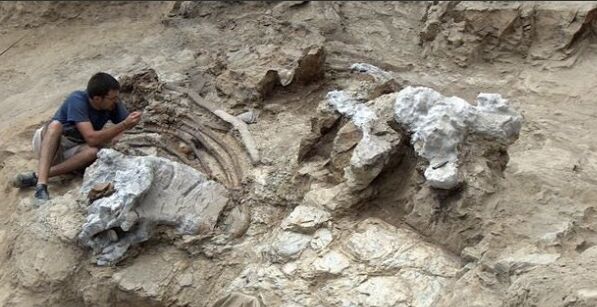Scientists Unearth Gigantic New Dinosaur Species, Shedding Light on Evolutionary Puzzle
Scientists have discovered a new species of giant sauropod dinosaur named Garumbatitan morellensis that provides insights into dinosaur evolution and connections between sauropod lineages across continents.
In a groundbreaking discovery, scientists have recently revealed the existence of a previously unknown giant sauropod dinosaur that roamed the Earth approximately 122 million years ago. This incredible find sheds new light on the complex puzzle of dinosaur evolution and has been named Garumbatitan morellensis after the location of its discovery in Spain. The fossils of Garumbatitan morellensis were first unearthed during excavations at the Sant Antoni de la Vespa fossil site between 2005 and 2008. This site has proven to be a treasure trove of dinosaur remains, with Garumbatitan morellensis being just one of the remarkable finds.
The findings of this discovery were published in a study in the Zoological Journal of the Linnean Society on September 28. Belonging to the sauropod group, Garumbatitan morellensis possesses the characteristic long neck, tail, small head, and sturdy four-legged structure. However, what makes this newly identified dinosaur particularly intriguing is its unique bone structure, suggesting it was quite primitive compared to other sauropods. This discovery could offer valuable insights into the evolution of these colossal, long-necked creatures that once dominated the Earth.
Estimates suggest that Garumbatitan morellensis reached a towering height of 10 meters, making it one of the largest sauropods of its time. Its colossal size is evident from its meter-long vertebrae and a femur that could reach over six feet in length. Most notably, researchers were able to uncover two nearly complete and articulated feet, an extremely rare find in the fossil record. The sauropod family is renowned for its remarkable diversity and enormous size, and Garumbatitan morellensis adds a new dimension to our understanding of their evolutionary history.
It belongs to the subgroup known as Somphospondyli, which is considered one of the most diverse and primitive sauropod groups. This finding also suggests connections between sauropod lineages in Europe, Asia, North America, and Africa, indicating periods of intercontinental dispersal. This discovery is not only thrilling for paleontologists but also provides valuable insights into the mechanisms of evolution, biogeography, and other scientific concepts.
As researchers continue to explore the fossil-rich deposits in the Iberian Peninsula, further revelations about the early evolution of these awe-inspiring giants that once roamed the Earth are expected. For more detailed information about this groundbreaking discovery, the complete study can be found in the Zoological Journal of the Linnean Society. This finding not only contributes to our knowledge of dinosaur evolution but also enhances our understanding of various scientific concepts crucial to the advancement of paleontology and related fields.




